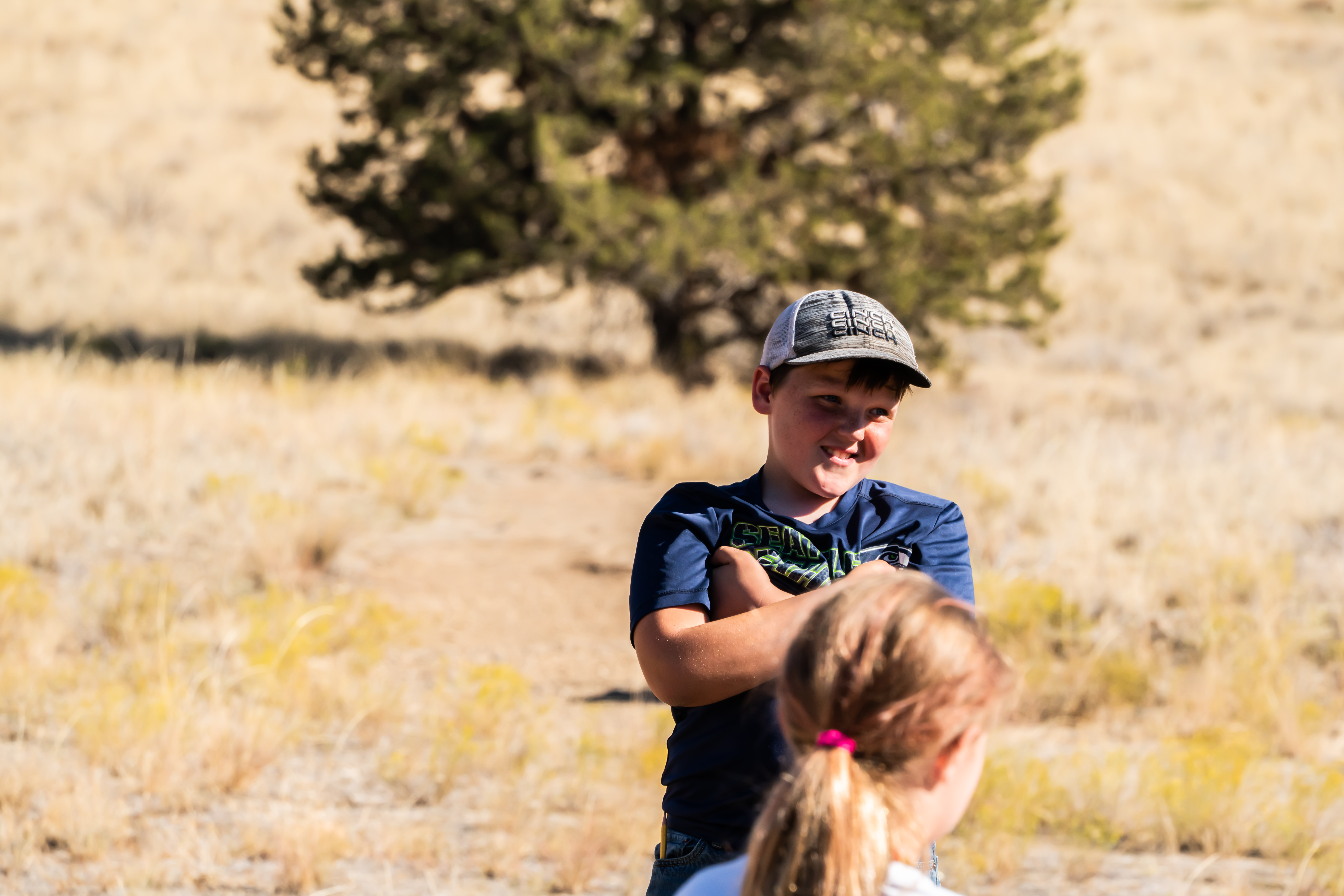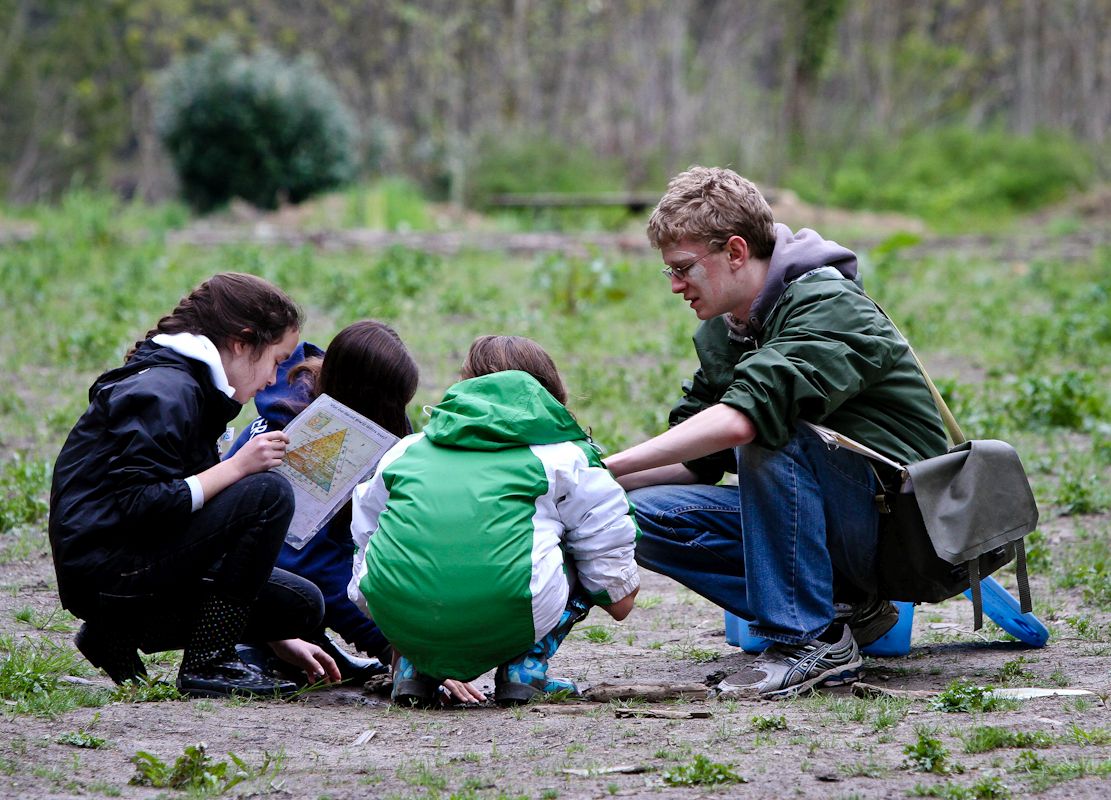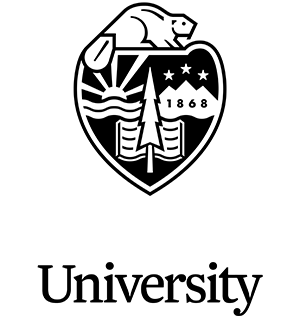2021-2022 EDAI Reporting Summary
In 2021-2022, we asked schools to select (from the list provided below) the supports provided to students with disabilities or students receiving special education while at outdoor school. Following each item is the percent of schools that selected that item as a support provided to their students.
- Behavioral 78%
- Mobility 49%
- Instructional 76%
- Medical 67%
- Special education collaboration 73%
We also asked schools to select (from the list below) the supports they provided to English language learners (ELLs) while at outdoor school. The percentage of schools selecting each support were:
- Interpretation services or language aides 32%
- Translated materials for students 36%
- Bilingual instructors/volunteers 29%
- Bilingual parents or chaperones 25%
To better understand how schools were addressing student needs, we asked them to select (from the list below) all of the historically underrepresented populations served by their outdoor school program and to describe how those students were served. We also asked what efforts they made to ensure all students can (want to) participate in outdoor school and we provided an optional text box for a more detailed description of the supports provided.

The populations of students we asked about included:
- Rural learners
- Low SocioEconomic Status students
- American Indian or Alaska Native students
- Asian students
- Pacific Islander students
- Black/African American students
- Hispanic/Latin(x) students
- Middle Eastern/North African students
- Gender non-conforming/LGBTQ+ students.
Each segment of text below includes the percent of schools that indicated they served students from the group specified and that percent is followed by a few selected quotes from school reports that reflect the variety of supports/responses provided.
63% OF SCHOOLS SUPPORTED AND INSTRUCTED RURAL LEARNERS
And their responses included:
"Our community is rural. Main efforts go for transportation. Students met at the school and then were transported to the camp. Communication was sent home via letters, emails, Facebook and district phone calls."
"Spray is a very small, rural community. We only have five 6th graders and two 5th graders. They haven't had the opportunity to do something like this for a while and many of them rarely travel very far from Spray."
"Our students have come from a very rural area, and many of them haven't been included in a summer camp, or outdoor experience. It was awakening for many of our kids, and they found great success and accomplishment in participating in this experience."
"The on site locations were situated near our rural school, and transportation was provided. Students can relate to these activities because they are familiar with the outdoors and things like soil, water, and weather as important resources for the farming community."

75% OF SCHOOLS REPORTED SUPPORTING AND INSTRUCTING HISPANIC/LATINX STUDENTS
And their responses included:
"All information about Outdoor School is sent home in Spanish for families. Additionally, our coordinator is bilingual and can facilitate any questions or information from families while at camp as well."
"St. Paul has a 50% Hispanic population. It would be nice for MESD to provide more Spanish speaking leaders."
"Our Hispanic population is English speaking and we rely heavily on our relationships and communication with families."
58% of schools reported supporting and instructing gender non-conforming/LGBTQ+ students
"Gender neutral bathroom - groups are not based on gender. Each student got to pick a friend in their group."
"All non-conforming/LGBTQIA+ students are included in all activities and are addressed by their preferred names and pronouns. Efforts were made to share information with volunteers."
"We have one student that may identify under these categories. As 6th grade is a time in life where many students are finding out who they are and may also have concerns with sleeping/showering around new people, the teacher made sure to check in students about people they feel comfortable around. Students were placed in cabin groups with another person whom they identified to be a comfortable person."
"ODS was equitable for all of our students. They were all provided with the same opportunities, including our Gender Non-conforming/LGBTQ+ students. Students were placed in mixed gendered groups, and student preferred pronouns and names were used by Grant and Canyonview staff."
"In 2017 MESD convened a working group of school administrators, staff, community members and others to create guidance for including and supporting transgender youth. That guidance is shared with all families and is posted to the Outdoor School website: https://www.mesdoutdoorschool.org/supporting-transgender-youth.html. Continuous efforts are made in coordination with school staff, parents, and community support groups to work to make ODS a place where gender non-conforming youth can belong. In fall of 2019 we consulted with our component School Districts in continuing to look at ways to improve our model and service for both High School students and 6th graders."
49% of schools reported supporting and instructing Asian students
"5th grade students attended that identify as Asian."
"Asian-American students are given all opportunities to participate. One student chose not to participate for personal/health reasons."
86% of schools supported and instructed low SES students
"We purchased clothing, shoes, and other equipment for those who could not afford it."
"We offered to families to purchase needed items ie. sleeping bags, pillows, boots, clothing, flashlights and toiletries"
"This is our primary population at the school. We do a lot of similar efforts for low SES that we do for Rural. All materials are provided for the students. This spring was very wet. Instead of assuming that all students would come with proper rain gear, we decided to make sure that all activities were under cover. In a "normal" year, we would even provide sleeping bags and pillows for students in need. All food was provided by the school's lunch program this year which was free to all families."
"Most students are from families that fall at or below the poverty line and our community has limited economical supports or resources available."
53% of schools reported supporting and instructing Black/African American students
"We encouraged and paid staff who were Black/African American to attend."
"We validated and made space for students and staff to share their authentic selves, their emotions and foster a culture of honesty and support rather than toxic positivity that can be often associated with white dominated fields and environments particularly in youth program settings. Students at the beginning of every field study heard their instructors share their stories of the land and invited students to share about their own relationships to the land including cultural traditions, fears of outdoors, and family legacies of caring for the land. We heard stories from students? families recreating outdoors in Iran to students? families who run rural farms in Oregon. They felt valued and included by opening up each field study this way, which helped build to trust and validate students' lived experiences inclusive of their culture and background. "
"This student groups is usually less than 1-2% of the student population, all are equally and equitably included."
"ODS was equitable for all our students. They were all provided with the same opportunities, including our Black/African American students."
"During staff training we focused on anti-racist and culturally responsive education practices to create an equitable and inclusive environment for all students particularly focusing on the experiences of BIPOC, LGBTQIA+ youth as well as students facing poverty and houselessness and students with disabilities and trauma histories. We offer rain gear to all students and carry extra clothing in case students come without the items they need to have fun and be safe and comfortable at Outdoor School."
"Our curriculum was redesigned to center Indigenous philosophies, worldviews and perspectives and challenge patriarchal, racist Eurocentric ideals like placing western science over traditional ways of knowing the land to start the work of dismantling education that shields white youth from the truths of the past and present racist and oppressive systems in our country."
"Approximately half of our staff are members of the LGBTQIA+ community including 3 out of 4 of our program leaders. We normalize pronoun use, offer genderless bathroom facilities, and lead as proud members of the queer and trans community to model to students that they are safe and welcome to be themselves at Outdoor School."
32% of schools reported supporting and instructing Middle Eastern/North African students
"We supported his conservative culture by encouraging a modest swimsuit."
"Messages home were in students' home language. Families were contacted to encourage participation. Personal phone calls and conversations and not having overnight school - so they could go home and eat culturally accustomed food."
"Communication with families in regard to the ODS experience, to provide familiarity with what students will be doing. This includes descriptions of documentation needed to attend ODS, descriptions of activities students will be participating in, and assurances of supervision of school staff and parent chaperones for the duration of the ODS experience. In addition, providing opportunities for families and students to ask questions about ODS, to allay any concerns they may have."

52% of schools reported supporting and instructing American Indian and Alaska Native Students
"CCMS has many (probably dozens) of native nations represented at the school. Clear Creek is also built on land that has been lived on for at least 1200 years and probably longer. We know that humans made their way up the Columbia River over 16,000 years ago and our area - known as a seasonal hunting and fishing ground - would gave been ideal for settlement. We have a long standing positive relationship with CTUIR. All of our Native American students attend ODS and we include several tribal agencies in the field studies program (tribal fisheries, local culture, etc.)."
58% of schools indicated they supported homeless/houseless students (2020-2021 was the first year we collected this data)
"All homeless and unhoused students who still live within the school district boundaries were transported to school daily and participated fully in ODS. Daily Camp supplies necessary to be successful were provided to any student who may need them."
"In our typical overnight model of programming, unhoused and homeless children have spaces to sleep and nutritious meals each day. If any student arrives at Outdoor School with limited gear or clothing, they have free access to our clothing closet and bedding for their comfort."
"We have lots of extra gear for our campers who might not have the best equipment or no equipment at all."
"Verified the students had all of the materials and supplies needed for Outdoor School through the District Homeless Liaison."
"Students were warmly encouraged to participate. Participation expectations were normalized and communicated early and often. Individual family concerns were listened to and addressed by teaching and administrative staff. Transportation was provided to and from school, and also to & from camp. Student supplies were provided, such as journals, writing utensils, water bottles, rain coats and mud boots. Meals & snacks were provided for all students to reduce any stigma associated. Communication to families was translated so that all parents and students could access information. All gender pronouns were honored and communicated to needed staff."
44% of schools reported supporting and instructing Native Hawaiian and Pacific Islander students:
"All Hawaiian and Pacific Islander students who still live within the school district boundaries were transported to school daily and participated fully in ODS."
"We have one student who is Native Hawaiian. Informational parent meeting was provided at the school, along with teacher/parent communication."
"Communication with families regarding the ODS experience, to provide familiarity with what students will be doing. This includes descriptions of documentation needed to attend ODS, descriptions of activities students will be participating in, and assurances of supervision of school staff and parent chaperones for the duration of the ODS experience. In addition, providing opportunities for families and students to ask questions about ODS, to allay any concerns they may have."
In 2020-2021, we also asked if schools reached out to their Title 6 Indian Education program or to their local Tribe in connection to outdoor school.
0 schools reported outreach to their local Title VI Indian Education programs.
13% of schools indicated they had reached out to their local tribes.

